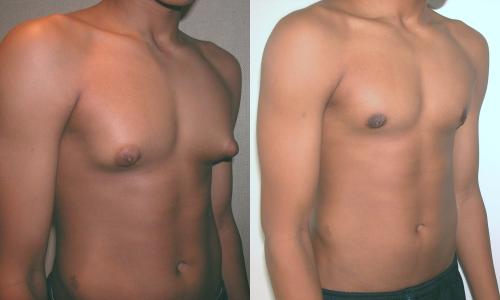Introduction
Popular media might give you the impression that it’s only women who suffer from body-image issues. Advertisements for weight loss products, liposuction, plastic surgery and treatment for medical problems such as anorexia and bulimia all predominantly feature women as their primary target market.
While these problems do merit attention, sometimes this media disparity can result in men feeling that their own body-image problems are pushed aside or seen as less important.
One medical problem in particular, that of male gynecomastia or ‘man-boobs,’ is underrepresented in the media and at worst, met with derision, when mentioned to or noticed by other men. This unkind attitude can make men too shy to reveal their upper bodies, or even too embarrassed to undress within sight of other men in changing rooms.
This article will cover basic information about the two main types of male gynecomastia, and offer suggestions to help men treat this problem.
What is Gynecomastia?
As mentioned above, gynecomastia is colloquially known as man-boobs or even ‘moobs’. The Oxford English Dictionary definition reads: “Enlargement of a man’s breasts, usually due to hormone imbalance or hormone therapy.” The official medical definition of gynecomastia states that this disorder is produced by hormonal changes, which excludes the related condition ‘pseudogynecomastia,’ as this is caused by obesity rather than unbalanced hormones. Similarly, the medical definition excludes enlargement of breasts related to or caused by cancer.
Gynecomastia by itself is a physiologically harmless condition, seldom causing more than embarrassment to patients, but it can in very rare cases be indicative of cancer.
What Causes the Condition?
Gynecomastia has one main cause: hormonal imbalance. Excess fat, or obesity, can also cause gynecomastia, and in this case it is termed ‘pseudogynecomastia.’
As hormone levels in humans are constantly changing, gynecomastia is actually very common in newborn children, adolescents, and elderly men. It usually resolves by itself in under 2 years, as development continues and hormones stabilize. The usual hormone implicated in gynecomastia is estrogen, although a decrease in testosterone can also be a cause. This is because the relative asymmetrical balance of testosterone and estrogen regulates male hormonal function.
Hormone levels can certainly be affected by other medical conditions, diets, and amounts of exercise, stress, and rest. Therefore, gynecomastia can occur at any stage of life, and may require hormonal treatment if it is not occurring in infancy, early adolescence, or late in life.
When teenage males and adult men take anabolic steroids for performance improvement, especially against the advice of a doctor, gynecomastia can result from these drugs, because they can cause hormonal imbalances that were not previously present.
As previously mentioned, obesity can cause enlarged breasts. This is not due to a hormonal change in the body, but rather, the presence of increased fat in a man’s upper chest that causes breasts to be bigger.
Diagnosis
For those who wish to treat gynecomastia, the cause must be firmly established. If it can be ascertained beyond any doubt that obesity is the reason for apparent gynecomastia, especially if no gynecomastia was present prior to obesity, then a sensible first-line treatment would involve the combination of improved diet and frequent exercise.
Secondly, if gynecomastia is occurring in infancy or early adolescence, nothing abnormal may be going on at all, which would mean that no treatment is required because the problem can resolve itself.
If these categories can be ruled out, then what must be considered next is if there are any obvious causes of hormonal imbalance due to supplements or hormonal therapy. As mentioned above, anabolic steroids are a likely cause for gynecomastia, and taking anabolic steroids without a medical doctor’s prescription is highly inadvisable. Ceasing such treatment may thus be the best way forward (preferably under the advice of a medical professional).
Many dietary supplements can affect testosterone and estrogen balance, which may have other noticeable effects on the male body. If mood fluctuations, acne, lack of facial hair, and unexpected vocal range are problems experienced by the patient, this can be an indication that hormones are out of balance.
For a professional understanding and treatment of hormonal issues and imbalances, you can talk to an endocrinologist. It is strongly recommended that a professional diagnosis is made before embarking on any medical treatment or taking any supplements that will affect hormonal balance, especially if imbalance is already suspected.
Gynecomastia Treatment
Once a diagnosis is confirmed and a cause considered likely, the treatment provider and patient will discuss further options. The provider may suggest natural/herbal supplements, prescription medication, change of existing hormonal regimens, diet and exercise changes, surgery, or any combination of the above.
Herbal treatments and dietary supplements can improve hormonal balance. As these tend to have the fewest side effects, they may be the first suggestion of the provider. They are often in the form of pills or creams. Possible treatments may contain proprietary blends, sclareolides, green tea extract, guggulsterones, and chromium picolinate, among other ingredients.
Prescription medication changes may include introduction of transdermal or injected androgens (male hormones), tamoxifen (an anti-estrogen drug), or cessation of previous regimens that included anabolic steroids.
Diet and exercise changes are most likely to be prescribed for pseudogynecomastia, but increased exercise and a healthier diet tend to benefit everyone.
Finally, the most invasive form of treatment is surgery, which definitely can have risks and side-effects, not to mention a high cost. This may, however, also be the most permanently effective solution. Surgery for gynecomastia often involves liposuction or removal of glandular tissue. Please note that many medical insurances are unlikely to cover such surgery, due to its being considered a cosmetic procedure.
Conclusion
While gynecomastia is relatively harmless, it can cause embarrassment and body image issues. It seldom portends cancer. If this condition causes you trouble and you are entirely certain you know the cause, you can attempt to treat yourself. However, it is safer and recommended that the condition is diagnosed by a physician, who will then help create a treatment plan that works for you.



Add comment